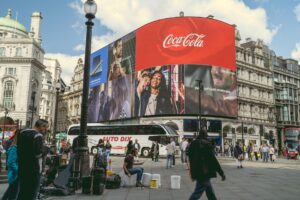What does Coca-Cola do to reach customers?

Coca-Cola is sold in more than two hundred countries around the world and represents nearly 43 percent of all carbonated beverages consumed in the United States annually. About 1.7 billion servings of Coke products are consumed every day.
Product
The products that Coca-Cola has used to capture the thirst of so many people go far beyond that iconic red can of soda. In fact, Coke makes so many different beverages that if you drank one per day, it would take you more than nine years to try them all. Coca-Cola has a product portfolio of more than 3,500 beverages (and 500 brands)—everything from sodas to energy drinks to soy-based drinks.[1]
Pricing
The pricing strategy of Coca-Cola is what they refer to as ”meet-the-competition pricing”: Coca-Cola product prices are set around the same level as their competitors, because Coca-Cola has to be perceived as different but still affordable. Coca-Cola uses lower price points to penetrate new markets that are especially sensitive to price. They meet or beat the competition on price to raise brand awareness. Once the brand is established in the market, Coca-Cola repositions itself as the “premium” brand in comparison to its numerous competitors (Pepsi, for example). One way they accomplish this is by promoting a brand image of bringing intangible benefits in lifestyle, group affiliation, joy, and happiness. But the marketing strategy still focuses on an affordable, premium product.
Promotion
Coca-Cola has a long history of memorable advertisements and promotions. In the early 1970s, Coca Cola released the “Hilltop” commercial (also known as “I’d Like to Buy the World a Coke”), which showed people from different races and cultures bonding over the beverage. For the 2014 Super Bowl and the Winter Olympics in Sochi, Russia, Coca-Cola launched the “America Is Beautiful” campaign.[2] Recognizing the growth of multicultural consumers in the United States, the campaign’s commercial featured seven young bilingual American women singing in different languages. It also showed culturally diverse consumers from all walks of life. Although the campaign was subject to severe criticism and sparked outrage and boycotts by some people, Coca-Cola was applauded by others for its commitment to a more inclusive marketing communication.
Place
Finally, the place, or distribution, of Coca-Cola products is truly amazing.
What does this marketing mix result in for Coca Cola? The Coca-Cola brand is worth an estimated $57.5 billion, almost three times as much as the closest competitor, Pepsi.[5]
- Coca-Cola. "Homepage." Official Coca-Cola® US Website. Accessed June 25, 2019. https://us.coca-cola.com/. ↵
- Patrick Kevin Day, “Coca-Cola Super Bowl Ad Stirs Controversy,” Los Angeles Times, February 3, 2014, https://www.latimes.com/entertainment/tv/showtracker/la-et-st-coca-cola-super-bowl-ad-stirs-controversy-20140203-story.html. ↵
- Id. ↵
- Id. ↵
- Interbrand. “Best Global Brands.” Accessed April 26, 2023. https://interbrand.com/best-global-brands/?filter-brand-sector=beverages. ↵